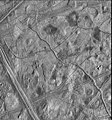File:Europa Domes.jpg
From Wikimedia Commons, the free media repository
Jump to navigation
Jump to search

Size of this preview: 558 × 599 pixels. Other resolutions: 223 × 240 pixels | 632 × 679 pixels.
Original file (632 × 679 pixels, file size: 177 KB, MIME type: image/jpeg)
File information
Structured data
Captions
Captions
Add a one-line explanation of what this file represents
| DescriptionEuropa Domes.jpg |
English: This moderate-resolution view of the surface of one of Jupiter's moons, Europa, shows the complex icy crust that has been extensively modified by fracturing and the formation of ridges. The ridge systems superficially resemble highway networks with overpasses, interchanges and junctions. From the relative position of the overlaps, it is possible to determine the age sequence for the ridge sets. For example, while the 8-kilometer-wide (5-mile) ridge set in the lower left corner is younger than most of the terrain seen in this picture, a narrow band cuts across the set toward the bottom of the picture, indicating that the band formed later. In turn, this band is cut by the narrow 2- kilometer-wide (1.2-mile) double ridge running from the lower right to upper left corner of the picture. Also visible are numerous clusters of hills and low domes as large as 9 kilometers (5.5 miles) across, many with associated dark patches of non-ice material. The ridges, hills and domes are considered to be ice-rich material derived from the subsurface. These are some of the youngest features seen on the surface of Europa and could represent geologically young eruptions. This area covers about 140 kilometers by 130 kilometers (87 miles by 81 miles) and is centered at 12.3 degrees north latitude, 268 degrees west longitude. Illumination is from the east (right side of picture). The resolution is about 180 meters (200 yards) per pixel, meaning that the smallest feature visible is about a city block in size. The picture was taken by the Solid State Imaging system on board the Galileo spacecraft on February 20, 1997, from a distance of 17,700 kilometers (11,000 miles) during its sixth orbit around Jupiter.
Deutsch: Dieses von der Weltraumsonde Galileo aufgenommene Bild der Oberfläche des Jupitermondes Europa zeigt seine komplexe Eiskruste, welche stark durch Brüche und Bergrücken verändert wurde. Anhand der relativen Positionen der überlappenden Bergrücken kann man ihre Altersabfolge bestimmen. So ist bspw. das 8km breite Band von Bergrücken in der linken unteren Ecke jünger als fast das gesamte übrige Gelände im Bild, aber ein schwacher dünner weißer Strich kreuzt es am unteren Bildrand (knapp unterhalb eines alten Bandes zu dem er parallel verläuft), der somit noch jünger ist. Dieser Strich wird wiederum von einem 2km breiten Doppelgrat, der von der unteren rechten zur oberen linken Ecke verläuft, geschnitten. Auf dem Bild sind auch zahlreiche Hügelgruppen und flache kreisförmige Erhebungen bis 9km Durchmesser zu finden. Diese Grate, Hügel, und Erhebungen sind wahrscheinlich mit aus der Tiefe aufsteigendem eisreichen Material verbunden und mit die jüngsten Oberflächenmerkmale Europas und weisen wahrscheinlich auf geologisch frische Eruptionen hin. Das Bild zeigt ein Gebiet von ungefähr 140 auf 130 Kilometer und ist auf 12,3° nördlicher Breite und 268° westlicher Länge zentriert und wird von rechts (Osten) beleuchtet. Die Auflösung beträgt etwa 180m/Bildpunkt. Das Bild wurde am 20. Februar 1997 aus einer Entfernung von 17'700km gemacht. |
| Date | image taken 20. Feb. 1997 |
| Source |
NASA planetary photojournal |
| Author | NASA/JPL/Arizona State University |
| Permission (Reusing this file) |
Copyright information from http://www.jpl.nasa.gov/images/policy/index.cfm - Unless otherwise noted, images and video on JPL public web sites (public sites ending with a jpl.nasa.gov address) may be used for any purpose without prior permission [...] |
| Public domainPublic domainfalsefalse |
| This file is in the public domain in the United States because it was solely created by NASA. NASA copyright policy states that "NASA material is not protected by copyright unless noted". (See Template:PD-USGov, NASA copyright policy page or JPL Image Use Policy.) |  | |
 |
Warnings:
|
File history
Click on a date/time to view the file as it appeared at that time.
| Date/Time | Thumbnail | Dimensions | User | Comment | |
|---|---|---|---|---|---|
| current | 06:44, 19 December 2015 |  | 632 × 679 (177 KB) | PlanetUser (talk | contribs) | Cropped < 1 % horizontally and < 1 % vertically using CropTool with precise mode. -- cropping edges |
| 17:31, 27 February 2011 |  | 633 × 680 (178 KB) | Bryan Derksen (talk | contribs) | Cropped off a narrow black band on the right edge of the image. Used the uncompressed .tiff file from the soruce URL as the source, so there shouldn't be recompression artifacts. | |
| 22:15, 10 February 2006 |  | 635 × 680 (140 KB) | Arnomane (talk | contribs) | {{Information| |Description = <br /> * '''en:''' This moderate-resolution view of the surface of one of Jupiter's moons, Europa, shows the complex icy crust that has been extensively modified by fracturing and the formation of ridges. The ridge systems su |
You cannot overwrite this file.
File usage on Commons
The following 2 pages use this file:
File usage on other wikis
The following other wikis use this file:
- Usage on de.wikipedia.org
- Usage on fr.wikipedia.org
- Usage on lb.wikipedia.org
- Usage on nds.wikipedia.org
Metadata
This file contains additional information such as Exif metadata which may have been added by the digital camera, scanner, or software program used to create or digitize it. If the file has been modified from its original state, some details such as the timestamp may not fully reflect those of the original file. The timestamp is only as accurate as the clock in the camera, and it may be completely wrong.
| JPEG file comment | converted PNM file |
|---|
Structured data
Items portrayed in this file
depicts
Hidden category: